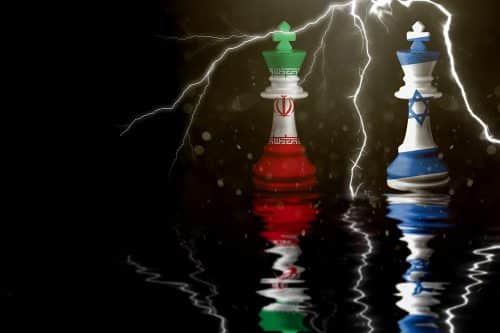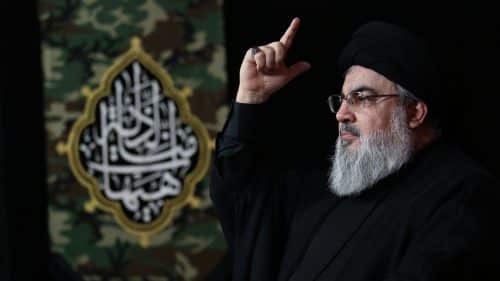A few years ago, Benjamin Netanyahu said in a speech he gave for the holiday of Purim, that already 2,500 years ago, Iran tried to annihilate the Jews. In response, Mohammad-Javad Zarif, then-Foreign Minister of the Islamic Republic, corrected Netanyahu, pointing to the fact that Haman was not Persian, and the person who in fact saved the Jews was the Persian king Ahasuerus, or in Persian Heshirasha.
Zarif got his facts straight, but both he and Netanyahu adopted a loosely accurate interpretation: the Islamic Republic and Iran are not one and the same entity.
The Jewish holiday of Purim, which is celebrated in the winter, offers an excellent opportunity to learn about the differences between the two.
The Book of Esther tells us about a beautiful Jewish girl who hides her identity and wins the king’s heart to become the queen of Persia. When the evil Vizier Haman, of Agagite (Amalekite) descent, contrives to kill all Jews in the kingdom, Esther reveals her identity and saves her people.
The story begins with the verse: “Now it came to pass in the days of Ahasuerus – this is Ahasuerus who reigned, from India even unto Ethiopia, over a hundred and seven and twenty provinces”. The name Ahasuerus leads us to the Achaemenid dynasty, to the Iranian perception of that dynasty nowadays, and to the connection of the above said to the pendulum of Iranian identity.
The voices of Ahasuerus and Cyrus resonate in Iran to this day.
Ahasuerus is the Hebrew version of the name of king Heshirasha. The timeframe of King Heshirasha’s rule tells us that the story of the Book of Esther begins in the third year into the reign of King Ahasuerus, and ends in his twelfth year on the throne, meaning the only option would be King Heshirasha the First and this sets the timeframe in circa 475/4 to 484/3 BC. The southern borders of Heshirasha’s kingdom were indeed India (the Indus Valley) to the Southeast, and Kush (present-day Sudan) in the Southwest, as the Book’s first verse tells us.
The expression “a hundred and seven and twenty provinces”, and the verse in chapter 1 of the Book that says “into every province according to the writing thereof, and to every people after their language” are relevant to Iranian current affairs. It is true that the number of provinces under Ahasuerus was in fact closer to 30-40 (127 is a typological number steeped with meaning but still, within that domain lived many nations and ethnic groups, who spoke many languages. Iran of today also consists of a patchwork of languages and dialects of many ethnic groups as well as many religions: aside from to the ruling Shi’ite Islam – the official religion of the country – we can find in Iran Suni Islam, Baha’is, Armenian and Assyrian Christians, Jews, Zoroastrians and other smaller denominations. Ethnically speaking – although the Persians are the largest group, there are many other ethnicities in Iran (Azeris, Kurds, Arabs, and Baluchis being the largest).
One of the most pressing concerns of the Iranians in regard to a revolution that would rid the country from the grip of the clergy, is the fragmenting of Iran. The regime indeed foments these fears, in its propaganda campaign, which was exposed when last November, hackers broke into the system of the Fars news agency – widely known as the regime’s trumpet. In fact, the protest, which started last September and is still called by many the “Woman-Life-Freedom Revolution”, had united the Kurds from the western region of the country, with Baluchis from the southeast, Azeris in the north and other groups – and still continues to do serve as a unifying force.
Ahasuerus belonged to the Achaemenid dynasty. His maternal grandfather, Cyrus, was loved and revered not only by the Jews but also by all of the region’s nations. When he conquered Babylon, he was welcomed as a savior. In the cylinder seal, containing the Edict of Cyrus – which also appears in the Bible in a version adapted to the Jewish faith – he reinstates the people to their gods, and rebuilds all of the ruined temples, appealing to the gods to sing his praise to Marduk. It is unclear whether Cyrus indeed believed in Marduk, or that he simply gave each nation a version of his appeal adapted to their faith. A mention of Ahura Mazda, the central god of Zoroastrianism – the religion of ancient Iran, is made by King Darius some eight-nine years after Cyrus’ death.
In any event, the Edict of Cyrus is considered the first declaration of human rights. In it, Cyrus grants the people the freedom to worship the god of their choice, providing they cause no harm to others in doing so. This is one of the reasons Cyrus is revered in today’s Iran as well, and he is mentioned in anti-government protests. In the years before the regime sealed off access to his tomb in Pasargad, Fars Province, anti-government Iranians would come in droves, filling the entire area to the horizon on “Cyrus Day” (the anniversary of Cyrus’ entry into Babylon and the establishment of the Achaemenid Empire) and similarly to the pilgrims at the Ka’aba in Mecca, they would circumambulate the tomb and chant “Cyrus is our father; Iran is our Fatherland”, as well as anti-government slogans.
The pendulum of Iranian Identities
This tradition takes us to the pendulum of Iranian identities, which swings from an Islamic identity that corresponds with the regional identity – to the Iranian identity, which is closer to the West.
In regard to the early centuries of the Islamic conquest, it would be somewhat anachronistic to discuss the concept of identity. But one can explore its religion and language: on one hand, the Iranians were Muslims and the language of prayer and scriptures was Arabic; but on the other – the mother tongue was still Persian – an Indo-European language. The very name of the country – “Iran” – means “of the Aryans”. Iranian culture and civilization were way ahead of their Arab counterparts, and Iranians always made certain to emphasize the difference between them and the Arabs. In fact, most Arab classics written in the Middle Ages, were penned by Iranians. Arabic was at the time the lingua franca – the common tongue – similarly to English nowadays. When the great scholars of the Middle Ages in Iran sought wide distribution, they wrote in Arabic: the physician Ibn Sina, the historian Biruni, the mathematician Al-Khuarizmi, and even the renowned grammarian of the Arabic language Sib-Buya (Persian for “he of the scent of apples”). In the 10th century, the Persian language was saved thanks to the poet Ferdowsi, who wrote the epic “Shahnameh” – “The Book of Kings”, in pure Persian. The sentiment that arises from “Shahnameh” is one of loathing towards the Arabic language and the love of Persian.
Today’s Iranians are proud of their connection to Cyrus, but the truth is that until the 19th century, most of them were not even aware of his existence. After the fall of the Achaemenid Empire to Alexander the Great in 333 BC, there was a period of 500 years in which the center of government was not in Persia, and all historical knowledge was lost. Mythological dynasties replaced the historic Achaemenid dynasty in national memory. Cyrus, Darius, Ahasuerus and most of the other kings remained documented only in the Bible and in the writings of Greek historians, and the single ruler mentioned in the post-renewal mythology is the last Achaemenid king, Darius III, referred to in mythology as “Dara ibn Darab”.
It was only in the 19th century that the Iranians recalled their affinity to the great kings of yore. Two key factors contributed to the awakening of the national Iranian pride: the surge of nationalism throughout the world, and new archeological discoveries that corroborated the existence of the figures, who till then were known only in Biblical stories and the writings of ancient Greek historians, and still, most Iranians remained, one could say, more Muslim than Iranian, and it was only knowledgeable intellectuals who suggested the Iranian identity as an alternative. The king at the time, Nasser ad-Din Shah Qajar, loved to travel to Europe and imitated the Europeans. Along the way also “sold Iran to Europeans” – by granting Europeans concessions in Iran that albeit advantageous to technological development in the country, would also put Iran’s money and resources in foreign hands. This incited the wrath of the people and swung the pendulum of the people’s identity far towards Islam. In fact, the Tobacco Protest – the first in a series of many protests to follow – began after the sale of a franchise over the entire Iranian tobacco industry to British buyers. A Sharia religious ruling that followed got all of Iran to quit smoking within a day (or within a week, depending on the myth), sinking the king in heavy debt. This is when the majority of people in the country used to smoke.
The movement of the pendulum of identities in Iran was felt throughout the 20th century, with the regime pulling to one side and the people* to the other. 20th century’s King Reza Pahlavi (Reza Shah) sought to emphasize Iran’s connection to the West to such an extent that he wanted to change the country’s international name from Persia to Iran – the name the country had always used. This name emphasizes that Iran was not the enemy of the West (the name “Persia” was established following the Greek documentation of the Achaemenid Empire) but Aryans – just like them. In 1935, King Pahlavi banned men from dressing in traditional Muslim garb and enforced a Western dress code of suit and hat. This act ended in a bloodbath at the Gohar Shad Mosque in Mashhad, when police forces tried to enforce the new dress code on worshippers. On the other hand, in 1936 the enforcement of the new dress code for women was successful. In January of that year, a ban was introduced on women wearing a headscarf outside the house, consequently causing many Iranian women not to leave their houses for about five years after its introduction – until Reza Shah was overthrown by foreign powers and replaced with his son Mohammad-Reza Pahlavi (“the Shah”).
Mohammad-Reza Shah aspired even more than his father for the secularization and Westernization of Iran, for the strengthening of the Aryan-Iranian identity, and for the undermining of clerical power. Some attribute the beginning of the Islamic revolution to an event in 1963 that was pretentiously dubbed the “White Revolution of the Shah and the People” – a revolution which did not exactly sweep the people, to say the least. Although it had indeed advanced Iran, it also led to the opposite political and social outcomes than expected, including the rise in the power of clerics and the strengthening of religious sentiment among Iran’s young people over the next 15 years. The phenomenon of mass devotion is beautifully depicted in the book “A Time to Betray” by Reza Kahlili. Khomeini’s famous speech of October 1964, in which he attacked the Shah, earned him a 15-year exile, in which he and his supporters cultivated popular religious sentiment and exploited it to undermine the regime.
There are some who pin the roots of the Islamic revolution in 1971, when the Shah held festivities to mark the 2,500th anniversary of Cyrus, and in a grand, overly-budgeted ceremony, swore his allegiance to Cyrus and proclaimed himself his successor. Dignitaries from around the world attended the ceremony, while the people were poor and starving. The squandering of Iran’s resources for such an ostentatiously lavish event did much to alienate the people from the Aryan-Iranian sentiment and push them to the arms of Shi’ite religion.
The Shah’s vision was ultimately realized: over the past decades, more than any other period in history, many Iranians have proudly come to embrace their ancient heritage, feel more connected to the legacy of Cyrus, adopt the Aryan-Iranian identity, disapprove of extreme interpretations of Islam and desire secularization and Westernization. The status of the clerics has never been at such a low, and consequentially, protesters have burned clerical offices and clerics are even attacked on the streets.
Women’s power
The important connection between the Book of Esther and today’s Iran is of course the power of women. As can be assumed from its name and its slogans of “Woman-Life-Freedom Revolution”, and as evident from the protest’s images and symbols – it revolves around women; it began because of a woman – Mahsa Amini, who was beaten to death by the Iranian security forces for wearing her hijab inappropriately. Her death sent thousands of girls and women out to the streets – some of whom have lost their lives as a result and have become symbols.
The Book of Esther begins with Queen Vashti’s refusal to appear before the king and his guest while they were “merry with wine”. Queen Vashti is commonly perceived as the first feminist, but she, in fact, simply complied with cultural and social imperatives – proper women do not appear before drunk men – that was reserved for mistresses and female dancers. She may not have thought that her defiance would cost her the crown, as Achaemenid women, according to Greek historians, were known to have intervened in their king husbands’, sons’ or brothers’ decision-making – at times literally reversing, changing or forcing rulings in matters of life and death. The Greeks called Ahasuerus – Xerxes, and his wife – Amstris, and she’s depicted as an immensely powerful woman, due to the manner in which she would yield her influence.
Until this day, Iranian women have better status as compared with their sisters in the Muslim world, but they are accustomed to fighting for their rightful place in their families and society. This is the reason why in many cases of immigrating families, it turned out that these are the women who are much more resilient than men, and effectively carry the burden of the family on their shoulders. Many Iranian women obtained the right to vote thanks to the White Revolution – even before their Swiss counterparts. The only Noble Prize won by an Iranian belongs to a woman, as does the country’s only Fields Medal.
The Iranian holocaust
Today, the Islamic Republic, through its various trumpeters, makes use of the story of the Book of Esther for anti-Semitic purposes. Various publications argue that the carnage described in chapter 9 of the Book is in fact history’s first genocide, which is inaccurate as it was not the first and is not truly documented in history. Many Iranians, including Israel sympathizers, believe this narrative and Iranian Jews celebrate the holiday of Purim with low profile as a consequence.
What has this taught us?
We see that each party to a discord can use a text – even a fictional one – for its own end and to justify its means. We see the difference between the Islamic Republic and Iran, with the vast ethnic diversity this beautiful country offers, and with the complexity of women’s status of Iranian women throughout history- from Vashti to Masih Alinejad, the prominent Iranian journalist in exile in the US, whom the regime is repeatedly trying to harm.
Dr. Tamar Eilam Gindin is a linguist, and an expert on Iran, who has authored several books on that culture. She is a member of the IDSF research department.
The views expressed in this article are those of the author and do not necessarily represent the views of the movement
*“The Iranian people” is a generalization that perceives an overall trend. But it is important to remember that almost every statement has its exception.





